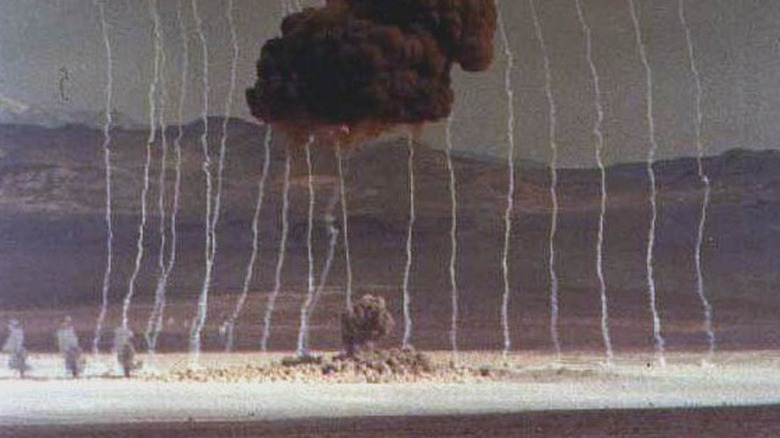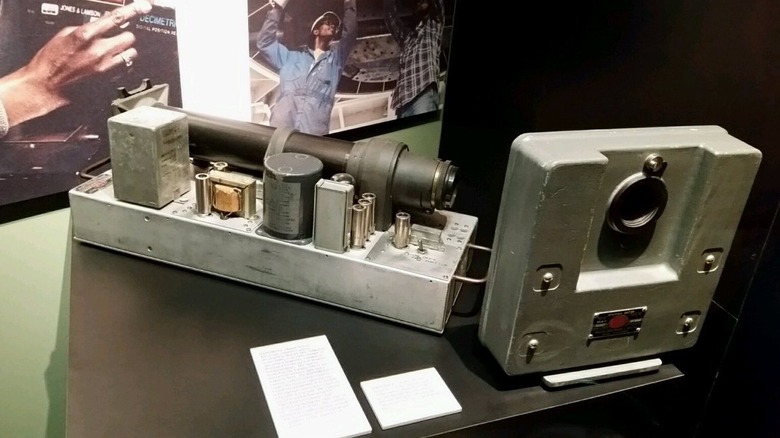Why Some Nuclear Explosions Have Vertical Smoke Trails Near Them
The early days of nuclear testing were a period of great discovery as scientists, researchers, and military personnel sought to understand the terrible power and full potential of what was unleashed upon the world. Part of that process was photographing and filming nuclear tests, and in some of those early photographs, there are curtains of white, wispy smoke. As The Drive explains, those streaks are unrelated to the atomic explosion itself, but rather a tool researchers developed to find out exactly what happens when an A-bomb blows up.
To understand what those curtains of white smoke in some old nuclear test photos and footage were for, one must first understand the two basic stages of an atomic explosion — as best as possible, that is, without an advanced degree in nuclear physics. First, there's the radiation, but then there's a shock front — or shock wave — a wall of extremely hot, highly compressed air rushing from the center so powerful objects are flattened in its path, per the Atomic Archive.
Closer in, the shock wave can be captured with special cameras, as the air itself glows and grows somewhat cloudy. As the front expands, the air cools somewhat and the front gets harder and harder to see with the naked eye. The destructive effect, though, remains — but for how long and how far? That's what early researchers needed to know. To get their data, scientists sought a way to make that powerful shock wave remain visible, and that's when those smoke trails came into play.
The shock wave seems to bend the smoke trails
Launched just a short time before a nuclear explosion, the white smoke from the rockets is captured as it appears to react in the refracted air — typically twisting, bending, or breaking — as the shock front expands. Using some fancy math, researchers could then figure out exactly how quickly and how far the shock wave had traveled once that reaction was seen. And in case you're wondering, the answer to that question is about 12 miles at around 784 mph at sea level, according to the Atomic Archive. Footage of the smoke effect can be seen above.
The idea came from the very first nuclear bomb test, Trinity, in 1945, when an optical illusion was noted in photographs. Part of a barrage balloon cable seemed to disappear in the picture, an effect created as the shockwave refracted light. Putting two-and-two together, special rockets were developed by the Naval Ordinance Laboratory (NOL) and were deployed in 1952 in Nevada, part of Operation Tumbler-Snapper, thought to be the first time the smoke-trail effect was tested. The contrails then showed up in Nevada testing footage and photos through 1955.
Special cameras were developed for nuclear tests
With or without the smoke test, early A-bomb test photos and footage would not exist without developments in camera technology, capable of capturing a cataclysmic explosion and its aftermath. Early on, Robert Oppenheimer and others involved in the Manhattan Project used an array of 52 high-speed cameras to gather data in the Trinity test, according to the National Museum of Nuclear Science and History. By the early 1950s though, rapatronic photography was developed, with an exposure time of just 10 billionths of a second, as The Nevada National Security Site (NNSS) explains.
In Nevada, rapatronic cameras were deployed in groups of up to 10 during Operation Tumbler-Snapper and subsequent tests, when the smoke rockets were also likely first utilized. Astonishingly fast, those types of cameras can only take one picture at a time, so groups were used to capture the explosion. And once those pictures were combined, scientists had a much clearer idea of the fearsome destructive power of nuclear weaponry, as well as precisely what happens in an atomic explosion.
Also notable, the shockwave measured in part by the smoke's reaction is just one threat created by an A-bomb blast. The radioactivity, alone, or nuclear fallout, from the two bombs dropped over Japan killed and sickened thousands of people long after the shock front subsided, according to the International Committee of The Red Cross.
[Featured image by Fizzotter via Wikimedia Commons | Cropped and scaled | CC BY-SA 4.0]

